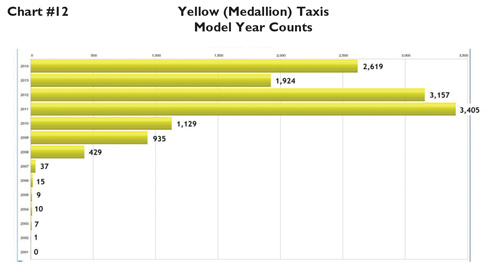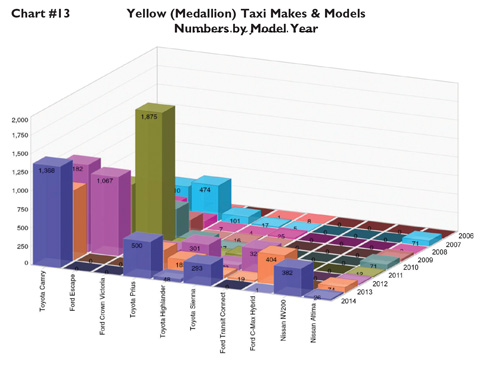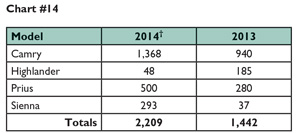|
||||||||||||||||
The following statistical study, as reported by Mr. George Lazlo, its creator, illustrates the numerical breakdown of the NYC Yellow Taxi, Limousine, Paratransit, Car Service industries as of July 2014. It is part of a larger study which includes his observations concerning NYC TLC operations. The entire report can be seen at: www.tlcentury.org
|
| Service Type | Vehicle Count |
| Commuter Vans | 468 |
| Paratransit Vehicles | 1,754 |
| Luxury Vehicles | 6071 |
| Black Cars | 15,625 |
| Community / Livery Cars | 27,933 |
| Yellow (Medallion) Taxis | 13,677 |
| Total: | 65,528 |
The study collected and analyzed data as of July 21, 2014 made available by the TLC via its web site or the New York City Open-Data initiative. The data was collected, cleaned, derived and charted for each industry segment individually and then pooled to allow cross segment analysis. The report includes 13 charts primarily focused on vehicle make, model and age. This article contains 4 of the 13 charts represented in the original report.
While recognizing the positive contribution made by the introduction of the Green taxi fleet in the outer boroughs during the Bloomberg era, the findings also reveal the following:
- The vast majority of Commuter Vans are between 7 and 12 years old;
- Sixty-six percent of Paratransit vehicles are between 4 to 7 years old;
- Roughly 50% of Community / Livery vehicles are between 7 and 11 years old;
- One-third of the SHL Green Cab fleet is 7 years or more old.
This is in contrast to:
- Yellow Cabs where 81% are four or less years old and
- Luxury Vehicles where 65% are less than 4 years old; and
- Black Cars where 3/4 are made up of cars model year 2010 or newer.
The study also determined that about 12% of Luxury Vehicles and nearly half of the Black Car fleet have come under the control of Uber in the past 3 years.
While Uber has set up and operates several bases in New York, it does not provide traditional dispatch services. Rather, the company matches drivers with passengers using its proprietary ride hail application. As such, it has no need to incur the overhead cost of traditional dispatch methods. Furthermore, the ‘app’ is generic and multi-purpose in the sense that it can be used for any type of private car hire service whether taxi, limo, rideshare, black car or luxury
Summary & Conclusions:
An analysis of the vehicle fleets within each segment of the New York City For-Hire Vehicle (FHV) industry was undertaken by the Taxi & Limousine Research Center (TLRC) using data collected by the New York City Taxi & Limousine Commission (TLC) as of July 21, 2014. The analysis showed that:
- The vast majority of Commuter Vans are between 7 and 12 years old;
- Sixty-six percent of Paratransit Vehicles are between 4 to 7 years old;
- Sixty-five percent of Luxury Vehicles are less than 4 years old;
- About 12% of the Luxury Vehicles have come under the control of Uber in the past 3 years;
- Nearly 3/4 of the Black Car fleet is comprised of cars model year 2010 or newer;
- Almost half of the Black Car fleet has come under the control of Uber in the past 3 years;
- Black cars controlled by Uber tend to be one year newer than those controlled by other bases;
- Roughly 50% of Community / Livery cars are 6 years old or newer; the other 50% are between 7 and 11 years old;
- Forty percent of the SHL Green Cabs are 4 or less years old;
- One third of the SHL Green Cab fleet is 7 years or more old;
- The SHL Green Cab fleet is dominated by Toyota Camry (newer) and Lincoln Town Car (older) vehicles;
- Eighty-one percent of the Yellow Cab fleet is 4 years or less old; 56% is 3 years or less old;
- Forty-five percent of the entire Yellow Cab fleet is comprised of Toyota vehicles with Camry dominating;
- Forty-three percent of the Yellow Cab fleet is divided between Ford Crown Victoria and Ford Escape models;
- Ford Crown Victoria and Ford Escape models are all two or more years older (i.e. are no longer being purchased);
- Only 382 Nissan NV200 “Taxi of Tomorrow” cabs were in service as of the study cut off date.
New York City has a population over 8 million. Millions more commute daily from surrounding areas. Tourism draws over 50 million visitors per year. These individuals depend on public transportation (buses, subways and trains), personal and rental cars, and a large complement of for-hire vehicles operated by private individuals and companies.
The private for-hire sector includes Yellow (Medallion) Taxis, Liveries (i.e. car services and community cars), Green (Boro) Taxis (a subset of cars drawn from the Livery pool), Black Cars (pre-arranged rides including corporate accounts), Luxury Limousines (pre-arranged rides including corporate accounts), Paratransit vehicles (pre-|arranged rides to/from healthcare facilities & for disabled individuals), and Commuter Vans (fixed route shared rides).
Yellow cabs carry 235 million passengers per year, or roughly 175 million trips per annum. Livery vehicles add 180 million passengers per year. Numbers for the other sectors are not readily available. It is too soon to tell how many passengers are served or trips made by Green cabs.

*Chart #11 only goes back to 2006, while the entire fleet can be traced to 2000.
It is clear from Chart #11 that the complement of Toyota vehicles is vastly newer than the Lincoln Town Car fleet. In fact, the majority of the Lincoln Town Cars are 2007 or 2006 models.* This could be interpreted that Lincoln Town Cars carry a halo effect that is not transferable to any other vehicle. It is probably also true that consumers have a tough time determining the age of a town car due to only minor design differences over the years. Given the age of this fleet, it is to be expected that their owners will be forced to purchase newer vehicles due to regulatory intervention, maintenance cost concerns and rising consumer expectations. The growth of eHail applications will only accelerate such upgrades.

As of July 21, 2014, there are 13,677 yellow cabs operating in New York City. While
popular perception is that yellow cabs are the most widely used in the city, statistics show that they operate primarily in the most densely populated parts of Manhattan (i.e. areas below 96th street) and to/from JFK and LaGuardia airports. Yellow cabs are also the only taxis that can be legally flagged down/hailed by passengers, a situation currently under assault by smartphone applications. In addition, yellow cabs can only be operated by individuals or corporations that own medallions. While medallion prices have typically increased year to year, they have also seen a drop in value caused by both the legal and illegal use of smartphone apps.
It is striking to see in Chart #12 that 11,105 out of 13,677 yellow cabs (81%) are four or less model years old. Fifty-six percent are three or less years old. A full 1/3 are two or less years old while 19% are current year (2014) models. It is clear that the TLC has much stricter rules for the service life of yellow cabs than any other for hire? vehicles. It is also clear evidence that market forces alone do not lead vehicle owners to provide newer cars to their passengers and that regulatory engineering can be used to work on behalf of the riding public.

The tallest bar and those behind it in Chart #13 shows the dominant position that Ford Crown Victoria has held in the last decade. It also makes clear, however, that since Ford no longer produces this vehicle those currently on the streets of New York will no longer be there within the next two years. When it comes to newer models, it is striking how dominant Toyota has become just in the past three years with their Camry, Prius, Highlander and Sienna models. As of July 2014, forty-five percent of the entire yellow cab fleet is made up of Toyota cars. Although a large number of Ford Escape taxis are in the current yellow cab fleet, Ford has sold an insignificant number of taxis in NY City over the past two years.
It is important to point out that the front row of Chart #13 only accounts for half of the year 2014, whereas all other rows represent full year counts. Keeping this in mind, it is quite unusual to see that the number of Toyota vehicles (of all models and especially Camrys) purchased in the first six months of 2014 (see Chart #14 below) exceed the total number purchased in the entire prior year!* The only plausible explanation for this is a retaliatory action by medallion owners against the Nissan NV200 mandate foisted on them by the TLC. By purchasing Toyota vehicles, medallion owners can put off buying the NV200 taxis by roughly 3 years while sending a loud and clear message to both the TLC and Nissan that they will not be easily forced to buy a single make and model over the next 10 years.
*As noted in the body of this report, all counts are based on model year designations. Thus, it is likely that a certain number of taxis designated as 2014 models were actually purchased in 2013. Since the same rule holds true for all other years, the findings and conclusions of the analysis remain valid.

†First six months of 2014 only
As of July 21, 2014, only 382 Nissan NV200 taxis were in use on New York City streets. Although not part of this analysis, the uptake of the NV200 taxis seems to have accelerated since July. According to Meera Joshi, head of the NY TLC, there are roughly 540 NV200 yellow taxis in the city as of December 18, 2014. This roughly translates to only 4% of the entire yellow cab fleet. Nissan has a long way to go before it can displace the 45% market share now owned by Toyota vehicles even if the “taxi of tomorrow” mandate succeeds.